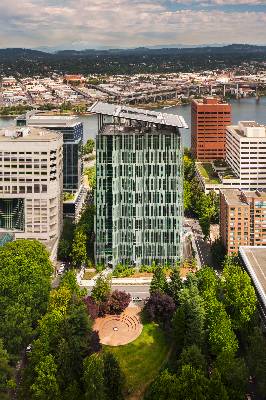
The Embodied Carbon Imperative: GSA’s Next Big Sustainability Opportunity
Post filed in: Sustainability
The United States faces a profound climate crisis and the U.S. General Services Administration is perfectly positioned to make significant progress in reducing energy consumption for the federal government. GSA is evaluating and reimagining our climate footprint across the full life cycle of federal buildings — not only the impacts of their daily operations but also the products used in construction and modernizations. Through more efficient operations and investments in facility infrastructure, the federal government reduced total energy consumption in facilities by over 40% since the 1970s.
As buildings become increasingly more efficient, the climate conversation has been expanding to consider the impact of building materials and the carbon embodied in the building itself.
Taking a quick step back, embodied carbon refers to the greenhouse gas emissions (mostly carbon dioxide) resulting from the mining, harvesting, processing, manufacturing, transportation, and installation of materials. Action in the next ten years is critical to address the global climate emergency. According to Architecture 2030, embodied carbon will account for 74% of the emissions from new construction over the next decade. Greenhouse gas emissions and energy use will continue to rise unless concerted effort is made to reduce the carbon footprint of building construction.
Federal mandates and targets, which GSA has consistently met and surpassed, have focused on operational energy; however, GSA is approaching the problem of embodied carbon at each step of the process: design, construction, and procurement decisions. The Green Building Advisory Committee, a team of industry and federal experts who advise GSA’s Office of Federal High-Performance Green Buildings, recently provided specific recommendations of steps GSA could take to reduce the embodied carbon of building projects. These include:
- Using materials in building projects whose product emissions fall within the best-performing 80 percent, as demonstrated by environmental product declarations.
- Using a whole building life cycle assessment for larger projects to show that the life cycle carbon assessment results in a 20% carbon reduction, compared to a baseline building.
The time to rethink the way we source our materials and build our federal buildings to support decarbonization efforts is now. In June, GSA will host a roundtable with stakeholders to facilitate a conversation about practical ways to work together to implement the advice of the Green Building Advisory Committee, set targets, and determine the feasibility of expanding upon the recommendations.
“Working on the President’s climate agenda is an exceptionally exciting and rewarding endeavor. GSA is absolutely ready to do our part in tackling the climate crisis,” said Kevin Kampschroer, director of the Office of Federal High-Performance Green Buildings, GSA. “Embodied carbon is a logical step in GSA’s efforts to reduce GHG emissions. It can be a lever to change how the government constructs and modernizes buildings, spur future building innovation, and spark materials creativity across the building industry.”
The Edith Green-Wendell Wyatt Federal Building in Portland, Oregon, was originally constructed in 1974 and underwent a major renovation between 2009 and 2013. Today the building is a cornerstone of GSA’s green building portfolio with all new mechanical, electrical, plumbing and data systems designed to make it one of the most energy efficient office buildings in the country. A recent analysis comparing the embodied carbon emissions from the actual retrofit project to a new matching building found that the renovation saved 53% embodied carbon emissions from a nearly identical building built new.


 U.S. General Services Administration
U.S. General Services Administration
